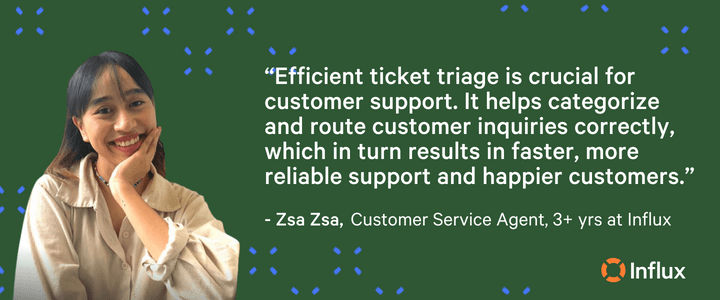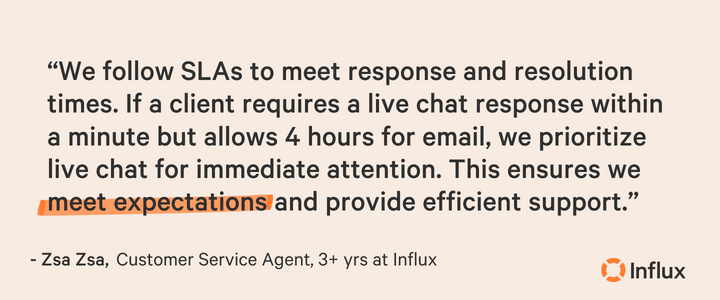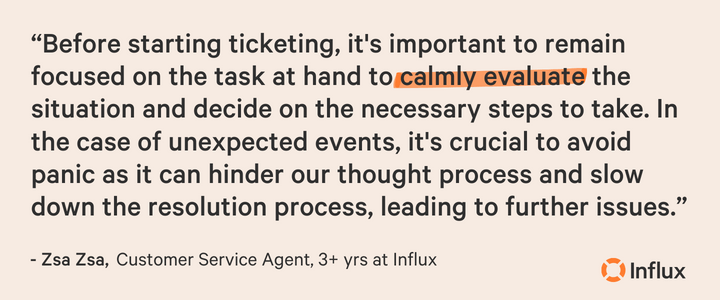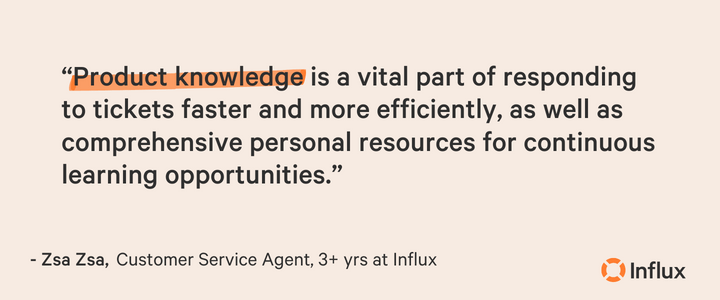Got backlog? Launch a fully managed support team in one week. Get started →{: target="_blank" rel="noopener"}
Two customer support tickets come into your helpdesk at the same time. How do you choose which ticket to respond to first?
All support tickets need to be answered promptly and accurately, as most of your customers’ experience is based on the type of customer service they receive, but some tickets are more urgent than others. The solution? Ticket triage.
We spoke with Zsa Zsa, an Influx Customer Service Agent of 3+ years, about prioritizing tickets for faster customer resolution and better backlog management{: target="_blank" rel="noopener"}.
What is ticket triage?
Ticket triage is the process of categorizing, prioritizing, and managing incoming support tickets based on their urgency and complexity. Categorizing and prioritizing tickets enables support teams to allocate resources so agents can focus on high-priority issues.
Customers like fast responses. As a way to manage and reduce backlog, ticket triage helps streamline the overall support workflow by routing tickets to the right agents, reducing the need for handoffs and unnecessary delays in issue resolution.
 {: width="720" height="300"}
{: width="720" height="300"}
Tips to prioritize support requests for faster resolution
1. Use tools to categorize and tag tickets for better organization
Influx customer service representatives rely heavily on helpdesk software like Zendesk and Gorgias to meet SLAs. These tools come with various features that streamline the ticket management process. For example, through tagging, agents can identify the severity of issues and organize tickets by category and age, addressing critical issues first to ensure that customers with pressing problems receive prompt assistance.
Productivity tools like Magical help minimize repetitive tasks with templates. Not only do templates save time by automating repetitive tasks, but they also maintain accuracy and personalization rather than sounding like a robotic response.
Zsa Zsa’s pro tip: balance automation and human interaction for a more personalized and efficient customer support experience.
2. Understand which tickets are a priority for better CSAT
Ticket prioritization is crucial to improve customer satisfaction and boost customer ratings{: target="_blank" rel="noopener"}. Clear organization demonstrates that a support team values and respects customers’ time and concerns. It also prevents support teams from spreading themselves too thin. Zsa Zsa shares a specific example of which types of tickets should be a priority.
I once worked with an eCommerce client, and I learned that some types of tickets require immediate attention. Examples of such tickets include requests to change an address, cancel an order, or make changes to an ongoing order. These issues must be addressed quickly before the status of the order changes. To ensure that customer needs are met promptly, we prioritized these high-severity tickets ahead of the low-priority ones. Once I have amended the customer’s inquiry, the customer is happy and satisfied and it will impact the CSAT, and my performance as an agent.
Understanding ticket prioritization is essential for delivering a transparent and responsive customer support experience.
 {: width="1440" height="400"}{: target="_blank" rel="noopener"}
{: width="1440" height="400"}{: target="_blank" rel="noopener"}
3. Establish a prioritization framework based on urgency, age of ticket, and complexity
Some issues require immediate attention, as they cause significant disruptions to the customer. Although all tickets are important and need to be resolved promptly, urgent issues should be given priority over low-priority ones. By resolving urgent issues first, Influx representatives can route the tickets effectively and then attend to the low-priority ones as soon as possible.
It’s also important to consider the age of the ticket. Influx agents strive to respond to inquiries as quickly as possible while taking the time to give each customer proper attention, so it's necessary to categorize tickets from oldest to newest. This way, we can ensure that customer issues are addressed immediately, and it helps to manage workload more efficiently.
Apart from ticket age, the complexity of the issue is another consideration that we need to pay attention to. Highly complex issues may require more time, so we should prioritize them accordingly to avoid longer resolution times. If we find a speedy resolution to a complex issue, we can then attend to other tickets faster. By prioritizing support requests based on their age and complexity, we can manage our workload more effectively and provide prompt and efficient customer service.
 {: width="720" height="300"}
{: width="720" height="300"}
4. Keep calm during unexpected events
When the support tickets come flooding in, things can get overwhelming. The ability to stay calm during unexpected events is a sign of a seasoned professional, something we train our agents on. By approaching challenges with a level head, agents can navigate incoming requests with efficiency and composure so each customer receives the best support.
See how ClassPass worked with Influx during a season of scale to resolve 250,000+ tickets in one month without compromising standards{: target="_blank" rel="noopener"}.
 {: width="720" height="300"}
{: width="720" height="300"}
5. Increase your support team’s product knowledge
A deep understanding of products or services means that agents have the knowledge to troubleshoot issues faster and with more accuracy, boosting agent confidence and customer satisfaction.
Moreover, when support teams are well-versed in the intricacies of the products, they are better prepared to handle unexpected spikes{: target="_blank" rel="noopener"} or challenges, adapt to changing circumstances, and provide informed guidance even in high-pressure situations. Continuous learning and product knowledge development are essential components of building a resilient and capable support team.
 {: width="720" height="300"}
{: width="720" height="300"}
Clear the inbox daily with Influx support
Strengthen your existing team and deliver omnichannel customer support with global support teams{: target="_blank" rel="noopener"}, trained to clear the inbox and stay ahead of ticket volume.
Tackle the backlog and get a handle on ticket volume with dedicated teams{: target="blank" rel="noopener"} trained to deliver fast, high-quality support to your customers. Let’s talk{: target="blank" rel="noopener"}!

 6 Circle - small.png)